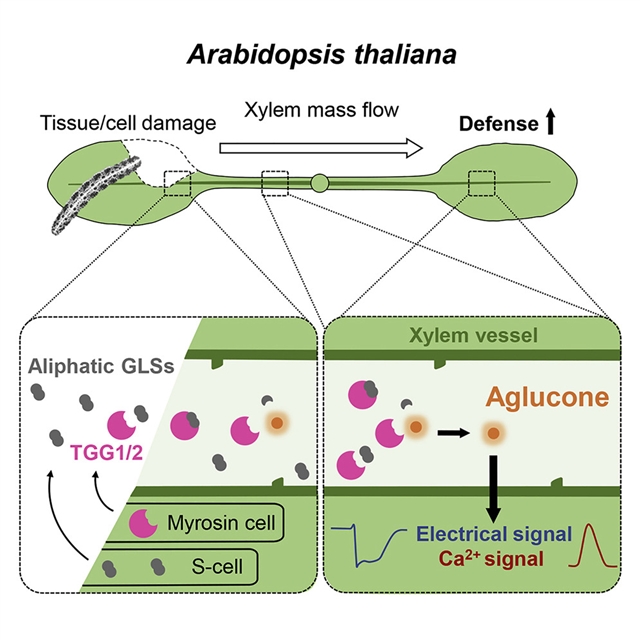Ricca因子可作为电信号的移动蛋白效应器

近日,瑞士洛桑大学Edward E. Farmer及其研究组发现,Ricca因子可作为电信号的移动蛋白效应器。这一研究成果于2023年3月3日在线发表在国际学术期刊《细胞》上。
研究人员在拟南芥中寻找叶对叶电信号的媒介,并确定它们是β-硫代糖苷糖化酶1和2(TGG1和TGG2)。在TGG1和TGG2突变体中,来自昆虫取食点的慢波电位(SWP)繁殖被强烈削弱,并且这些植物的伤口反应细胞膜Ca2+增加也被减少。重组的TGG1进入木质部引起类似野生型的膜去极化和Ca2+瞬时变化。此外,TGG还能催化葡萄糖苷酸的降解。代谢物分析显示,初级静脉中的脂肪族硫代葡萄糖苷因伤口而迅速分解。利用体内的化学诱捕,研究人员发现有证据表明葡萄糖酸酯水解产生的短命的聚糖中间物在SWP膜去极化中的作用。这些研究结果揭示了一种机制,即器官间的蛋白质运输在电信号中起主要作用。
据了解,食叶昆虫触发高振幅的、诱导防御的电信号,称为SWP。这些信号被认为是由被称为Ricca因子的低分子质量诱导剂的长距离运输所触发的。
附:英文原文
Title: Ricca’s factors as mobile proteinaceous effectors of electrical signaling
Author: Yong-Qiang Gao, Pedro Jimenez-Sandoval, Satyam Tiwari, Stéphanie Stolz, Jing Wang, Gatan Glauser, Julia Santiago, Edward E. Farmer
Issue&Volume: 2023-03-03
Abstract: Leaf-feeding insects trigger high-amplitude, defense-inducing electrical signals called slow wave potentials (SWPs). These signals are thought to be triggered by the long-distance transport of low molecular mass elicitors termed Ricca’s factors. We sought mediators of leaf-to-leaf electrical signaling in Arabidopsis thaliana and identified them as β-THIOGLUCOSIDE GLUCOHYDROLASE 1 and 2 (TGG1 and TGG2). SWP propagation from insect feeding sites was strongly attenuated in tgg1 tgg2 mutants and wound-response cytosolic Ca2+ increases were reduced in these plants. Recombinant TGG1 fed into the xylem elicited wild-type-like membrane depolarization and Ca2+ transients. Moreover, TGGs catalyze the deglucosidation of glucosinolates. Metabolite profiling revealed rapid wound-induced breakdown of aliphatic glucosinolates in primary veins. Using in vivo chemical trapping, we found evidence for roles of short-lived aglycone intermediates generated by glucosinolate hydrolysis in SWP membrane depolarization. Our findings reveal a mechanism whereby organ-to-organ protein transport plays a major role in electrical signaling.
DOI: 10.1016/j.cell.2023.02.006

用户登录
还没有账号?
立即注册